Monday, October 4th, 2021
Infrastructure
Next to COVID, no issue has been more controversial
By Leslie Gartrell
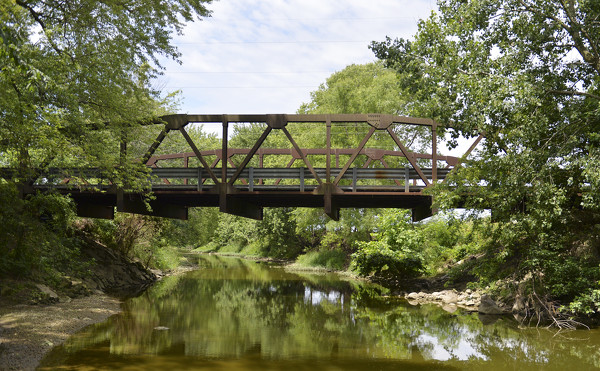
Photo by Dan Melograna/The Daily Standard
MER-CO21B-0477. A truss bridge over the Wabash River south of State Route 219.
CELINA - On a hot June day on the Wabash River, Mercer County engineer Jim Wiechart discussed one of the favorite parts of his job: bridge inspection.
One such bridge, located on Wabash Road south of State Route 219 in Washington Township, was built in 1993. By Wiechart's standards, it's a relatively new structure. Bridges and roads can last 70-80 years with proper care and maintenance, he said.
Although the bridge is less than 30 years old, Wiechart said it's one of the worst structures in service in the county.
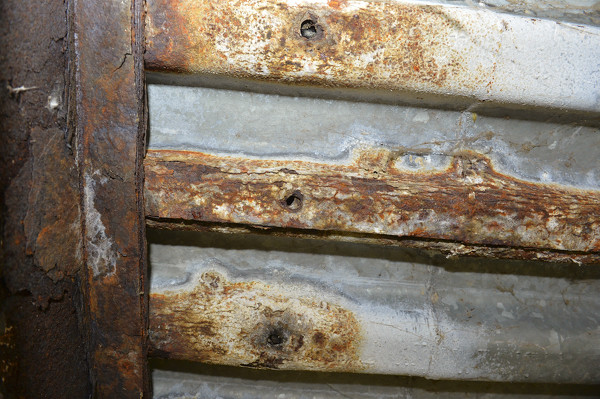
Photo by Dan Melograna/The Daily Standard
Beneath the bridge: Considerable rust and holes where bolts used to be. Built in 1993, the bridge's status is "structurally deficient."
"You might want to close your eyes," Wiechart cautioned. He hammered on the web of the bridge's truss. Chunks of rusted metal fell from above. Some landed at Wiechart's feet and others tumbled into the river.
Wiechart is responsible for much of the county's physical infrastructure, including the 381 bridges, 385 miles of roads and more than 100 miles of open and tiled ditches.
If his job has taken on added significance recently, it's because infrastructure is in the news.
In May, a major bridge over the Mississippi River developed a huge crack and it was closed for weeks. A 12-story condominium in Florida collapsed in June, killing nearly 100 people. And in Washington, a $1.7 trillion infrastructure bill is slowly winding its way through Congress.
Wiechart and Auglaize County Engineer Andrew Baumer estimate it could cost as much as $30 million to bring bridges in both counties up to today's standards.
The Daily Standard has spent months examining some of the area's infrastructure and interviewed officials on roads and bridges, local water systems and public school buildings. The news is both good and bad.
Roadways, bridges
Ohio maintains one of the most extensive and heavily travelled roadway systems in the nation, according to the American Society of Civil Engineers (ASCE).
The state has more than 44,000 bridges and nearly 123,000 miles of roadway, according to the ASCE. Ohio has the second highest number of bridges behind Texas in the U.S. and the fourth highest volume of interstate miles. Ohio also has the fifth highest traffic volume and the third highest interstate truck traffic. Annually, $1.1 trillion in goods are shipped to and from sites in Ohio, primarily by truck, according to the ASCE.
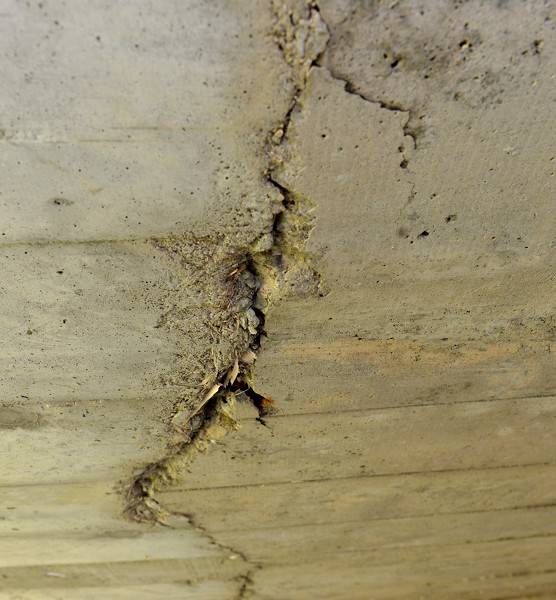
Photo by Dan Melograna/The Daily Standard
MER-CO20B-600. A huge crack runs underneath the old bridge on Huwer Road. Elsewhere, broken concrete exposes iron bars.
The ASCE this year gave Ohio a C- in its first infrastructure report card in more than a decade. Ohio bridges received a C+ and roads a D. An A is considered exceptional and fit for the future and an F is deemed failing, critical and unfit.
In Ohio's case, the overall C- rating and C+ for roads indicate the infrastructure is mediocre and requires attention, according to the ASCE. The state's roads received a D, meaning the infrastructure is poor and at risk.
Ohio Revised Code defines a bridge as "any structure of 10 feet or more clear span, or 10 feet or more in diameter, situated on, above, or below a highway," and requires all bridges to be inspected annually.
Comparatively, the Federal Highway Administration defines a bridge as a structure that is 20 feet or longer and requires an inspection frequency of two years.
Ohio's 10-foot-long bridge definition and greater inspection frequency places a higher level of responsibility on bridge owners in the state, according to the ASCE. Ohio is the only state with this requirement.
Mercer County
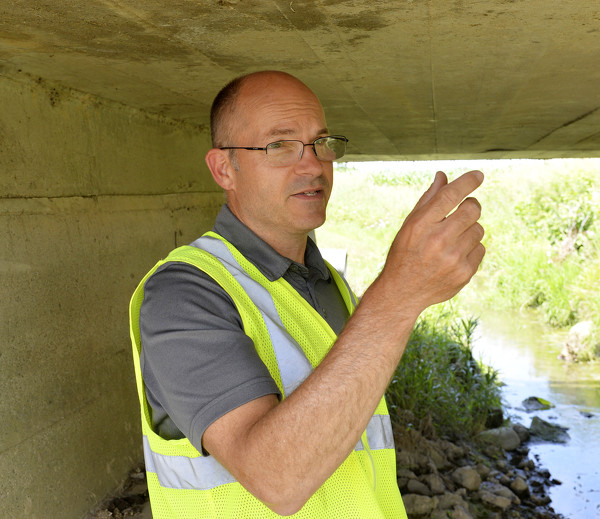
Photo by Dan Melograna/The Daily Standard
Mercer County engineer Jim Wiechart looks under MER-CO20B-600, a bridge on Huwer Road in Marion Township. Its status: "functionally obsolete."
Wiechart, who's been in his position since 1999, said preventative maintenance and planning has kept the county's bridges and roads in good shape.
Wiechart oversees the county's bridges, roadways and drainage infrastructure. The engineer's office is also responsible for maintaining any culvert that is 36 inches in diameter or larger on township roads. A culvert is a structure that allows water to flow under a road or other obstructions from one side to another, Wiechart said.
The county's bridges are mostly in good shape, Wiechart said. No bridges in the county are closed, and only five have reduced weight limits. Wiechart attibutes load postings on those bridges to policies that allow bigger and heavier vehicles on bridges.
The truss-style bridge over the Wabash River in Washington Township is a slightly different story. Officials started to pay more attention to it around 2016. It has a reduced weight limit in place. Wiechart said if the bridge continues to deteriorate, its weight limit could be lowered again before it is reconstructed in 2022.
Wiechart said had it been built as a redundant-style bridge, its lifespan would be longer. A redundant bridge has several points of support, he explained. If something happens and one of the support beams is damaged, the bridge would have several other beams for support, greatly reducing the risk of collapse or further damage. The truss bridge, however, only has two points of support, Wiechart said.
The county has three truss bridges, all of which are up for replacement soon, he said. The Mercer County Engineer's office has acquired federal money to reconstruct the truss bridge over the Wabash, starting in 2022. Wiechart said the estimated cost is around $825,550.
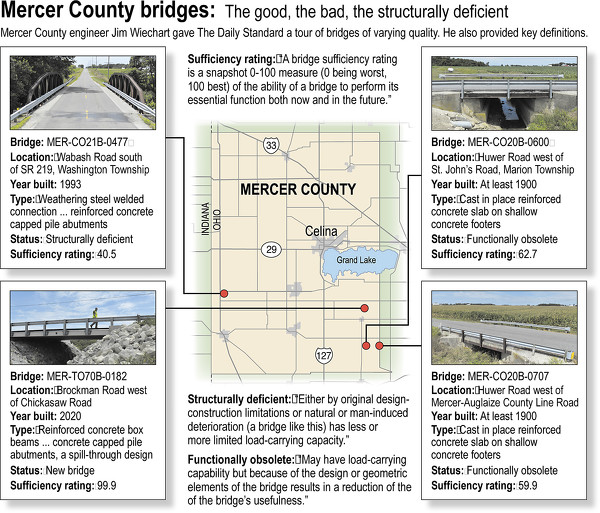
Photo by Bill Thornbro/The Daily Standard
Bridge Terminology:
Sufficiency rating: "A bridge sufficiency rating is a snapshot 0-100 measure (0 being worst, 100 best) of the ability of a bridge to perform its essential function both now and in the future."
Structurally deficient: "Either by original design, construction limitations or natural or man-induced deterioration (a bridge like this) has less or
more limited load-carrying capacity."
Functionally obsolete: "May have load-carrying capability but because of the design or geometric elements of the bridge results in a reduction of the of the bridge's usefulness."
Wiechart said of the county's 380 bridges, 17 are designated structurally deficient. Bridges are considered structurally deficient if they have been restricted to light vehicles, closed to traffic or require rehabilitation, Wiechart said. It means elements of the bridge need to be monitored and perhaps repaired.
The fact that a bridge is structurally deficient, however, does not mean it is likely to collapse or that it is unsafe, Wiechart said. It means the bridge must be monitored, inspected and maintained.
Nine bridges in the county are designated functionally obsolete, Wiechart said. This means the bridge was built to standards that are not current, he said. These bridges are not automatically rated as structurally deficient, nor are they inherently unsafe, he said.
Functionally obsolete bridges are those that do not have adequate lane widths, shoulder widths or vertical clearances to serve current traffic demand. They also may suffer occasional flooding, he said.
For example, a bridge could be considered functionally obsolete if it is more narrow than current standards allow, Wiechart said. The bridge is not inherently dangerous or falling apart - it was simply made at a time when standard bridges were more narrowly constructed.
In-house bridge work

Photo by Dan Melograna/The Daily Standard
Siegrist Jutte Bridge. Workers tear down the old, narrow bridge and replace it.
Wiechart's office is a one-stop shop for the majority of the county's bridge maintenance, repair and reconstruction. County employees are capable of planning, engineering, designing and pre-fabricating most of the materials needed for bridges and culverts.
The county engineer's office can make any structure up to a 40-foot span in-house without having to bid out projects or go through third parties, Wiechart said. It's beneficial to do what they can themselves, he said, because the staff has more control over the project. Using a contractor could result in a lengthier, more expensive process.
Wiechart said the bridge crew completes the construction, excavation, channel alignment and the embankment to which the bridge connects. Channel alignment involves how water flows under the bridge, Wiechart said. If the channel isn't even or flows predominantly along one side of the bridge, it could cause the bridge to deteriorate faster because of erosion.
Work along a bridge's embankment adjoins the bridge to the land, making it more stable. This often improves the roadway approach and the bridge's structure, he said.
Wiechart said his staff over the years emphasized preventative maintenance and repairs. Because of that, Wiechart said his employees repair or replace only six to eight bridges per year.
While bridge repair and maintenance is important, taking care of county roads is, too, Wiechart said.
Since 2017, the Mercer County Engineer's office has placed a minimum of 50 miles of county road chip and seal. In the last four years, 233 miles of chip and seal has been completed, or about 61% of the total county road footprint, according to the engineer's annual report for 2020. In 2020, that amounted to 62 miles that were chip and fog sealed.
Chip sealing is a widely-used alternative to traditional asphalt that allows workers to treat four times as much roadway for the same cost, according to the Ohio Department of Transportation. Chip sealing extends pavement life by five to seven years before a full resurfacing is necessary. Chip sealing is done by first cleaning debris from roadways and then patching holes. Workers apply hot liquid asphalt and spread crushed rock on top. Excess rock is swept away, fog seal is applied and road markings are reapplied, ODOT says.
Fog sealing is the application of a final layer of asphalt emulsion, which provides additional waterproofing and a layer of security for the crushed rock, according to ODOT.
In 2020, for the second year in a row, Wiechart's office was able to access Ohio Public Works Commission funds to widen three roads. Wiechart said road widening is critical, considering the heavy agricultural equipment that travels over them.
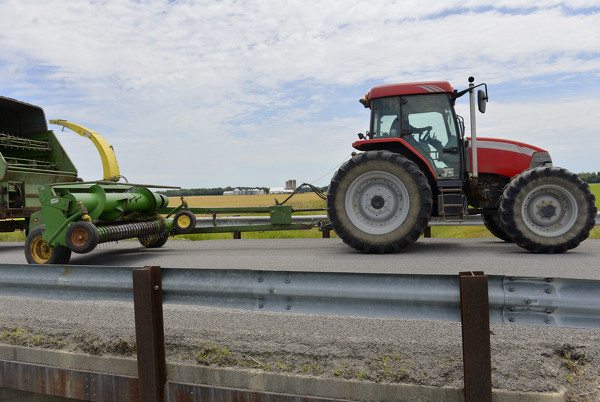
Photo by Dan Melograna/The Daily Standard
MER-C20B-707. Heavy farm machinery is hard on county roads and bridges.
Widening county roads to accommodate farm equipment has become increasingly important, Wiechart said.
"The big Kahuna … is improving our roadway corridors, our county roads, to accommodate that bigger (agricultural) traffic, widening shoulders and also trying to widen pavement over time," Wiechart said. "Those are things that we're really focused on, and hopefully something we will focus on for the next 10 to 20 to 30 years."
Wiechart said a long-term goal is to have all county roads widened to a minimum width of 24 feet by the year 2044.
Wiechart said it will take millions of dollars to bring all of the county's worst bridges up to modern standards.
"In a perfect world to bring all our worst bridges up to new conditions meeting today's standards without wasting any of our funds, you are talking in the realm and scale of $10 to $20 million," he said.
Auglaize County
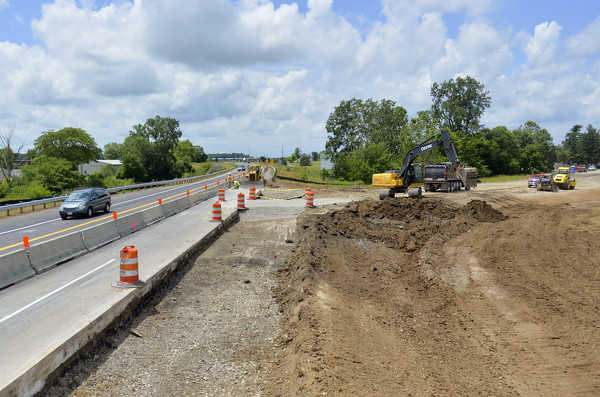
Photo by Dan Melograna/The Daily Standard
Crews work at U.S. 33 and Wapakoneta-Fisher Road in Auglaize County to fix the county's most dangerous intersection.
Auglaize County Engineer Andrew Baumer drove the company truck to the intersection of U.S. 33 and Wapakoneta-Fisher Road. Construction equipment lined the road as hardhat-wearing construction workers toiled away.
Baumer said it's the most dangerous intersection in the county.
"When you came from the south, you really had to turn and crank your head to see what was coming," he said. "There's a bunch of traffic obviously on U.S. 33, but also traffic coming across or trying to turn. There was 11 decision points you had to make sitting at that intersection, which led to a lot of mistakes driving-wise or blind spots."
With the new construction, drivers will only have two decisions to make - looking left and right before turning.
"The more decisions you can limit the better," Baumer said. "If you have to think of 11 things before you make a turn, it becomes pretty dangerous."
A traffic study for the project showed semi-trailers accounted for 36% of the vehicles on U.S. 33. It was an already busy road, Baumer said, but the heavy traffic from semi-trailers compounded the issue.
Baumer said he and his team worked for six years to acquire funding and complete planning for the project. A safety grant from ODOT paid for 10% of the project. Baumer put the total cost around $2 million. Ohio Department of Transportation crew members worked alongside county workers because the project was on U.S. 33.
Baumer has been with the department since 2009 and helps oversee the county's roughly 350 miles of county roadways, which include more than 2,200 acres of road rights-of-way and more than 4,000 drainage culverts.
The engineer's office is also responsible for the inspection and
maintenance of 349 county bridges, 359 miles of subsurface and open drainage ditches and 323 miles of public highways. The county engineer inspects 20 bridges located in municipalities, but maintenance and replacement of those bridges is the responsibility of the municipality.
"It's constant maintenance," Baumer said. "It's challenging to do all that as effectively as possible and stretch funding as far as possible."
Baumer said he believes the county's bridges are in good shape overall. Bridge technician Marshall Miller said the county has 322 bridges rated in good condition, 45 rated in fair condition and only one rated as poor. Miller said the single county bridge in poor condition is on a dirt, dead-end road that is not traveled on by the public. The bridge is up for replacement next year.
"We are fortunate to have such good bridge infrastructure in Auglaize County," Miller said.
Like Mercer County, the Auglaize County engineer's office is capable of designing, planning, pre-fabricating and constructing most of its own bridges. Auglaize County can pre-casting its own concrete bridge beams, which they usually make in the winter before a project starts.
Baumer said he and his coworkers are able to build bridges up to 60 feet long. His office typically repairs or reconstructs between 10-12 bridges each year.
Also like Mercer County, Baumer said agricultural equipment has to be taken into consideration whenever planning new road, bridge or culvert project.
Baumer said if money were no object, it would likely cost about $10 million in materials and labor and $5 million in planning to bring every bridge in the county up to new conditions and today's standards.
The future of funding
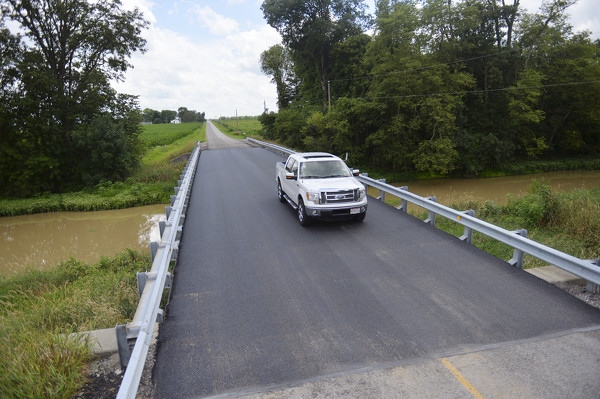
Photo by Dan Melograna/The Daily Standard
A truck drives over the recently finished bridge on Townline-Lima Road in Auglaize County.
Funding for transportation projects comes from several revenue streams, Baumer and Wiechart said. Funds are derived from taxes, both federal and state on gasoline and diesel fuels, permissive license tag fees and other sources.
The primary revenue source is gas tax revenues, they said. Ohio per-gallon tax rates are 38.5 cents for gasoline and 47 cents for diesel. In 2019, Ohio House Bill 62 increased the per-gallon gas and diesel rates by 10.5 cents and 19.0 cents per gallon, respectively, for the first time since 2006. ODOT receives the majority of those funds, Baumer said, while the remaining money is allocated among Ohio's 88 counties.
Wiechart said the 2019 gas tax adjustment was overdue for the infrastructure needs at hand and was phased in late 2019. As a result, revenue for roads and bridges were well below what the General Assembly intended for 2020 and 2021, Wiechart said.
The federal motor fuel tax of 18.4 cents per gallon has not been increased since 1993. This tax is used to support the Highway Trust Fund, the major source of federal surface transportation funding.
"The tax was also not indexed for inflation and only has 60% of the purchasing power it had when first enacted," the ASCE's Ohio infrastructure report card notes. "Because of this, Congress has resorted to transferring general revenues to the Highway Trust Fund since 2008. Continued general fund transfers to support highway projects are not a long-term solution to transportation funding needs."
Ohio also is considered a donor state, meaning it receives less in gas tax receipts than it collects from the Highway Trust Fund. In fiscal year 2019, Ohio collected $2.06 billion in federal fuel receipts but only received $1.78 billion in ODOT's annual budget, according to ASCE.
At the same time, Baumer and Wiechart said the increase in electric vehicles and the impact of the COVID-19 pandemic have highlighted cracks in a funding formula dependent on gas consumption.
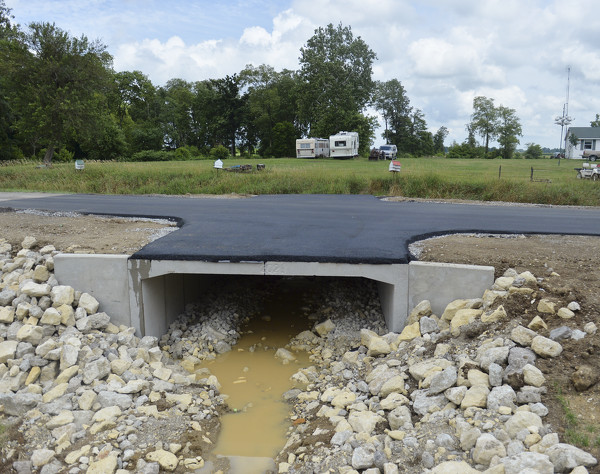
Photo by Dan Melograna/The Daily Standard
A finished box culvert on Townline-Lima Road in Auglaize County.
The pandemic significantly reduced travel, which has lowered the amount of funds each Ohio county received from the fuel tax. Baumer said Auglaize County lost about $280,000 in anticipated funding because of the gas tax loss.
"We got a gas tax increase a couple years ago for the first time since 2006, that's been a nice shot in the arm to help with some of our road improvements," Baumer said. "But we're still not at a cycle where we want to be as far as maintaining our roads as well or as often as we'd like."
"Bridges are a similar animal," Baumer continued. "Material and construction inflation has continued to rise. Something like this (Wapakoneta-Fisher Road improvement project) that started six years ago … because of the inflation, by the time you actually get to construction, that project cost a lot more than what you thought it would."
Wiechart said his office also has been affected by the loss of gas tax revenue. The year-to-date gas tax revenue for Mercer County was down by approximately $442,547 because of the gas tax loss, Wiechart said.
Wiechart said his office has applied for two projects with the county commissioners that would be funded in part by American Rescue Plan funds. He said his office and the county commissioners would use the revenue reduction and stormwater provisions of the American Rescue Plan to offset the reduction in funds roads and bridges have experienced.
"There is a lot of federal money being injected into the local government but no certainty that any of it will go into roads and bridges, as the (county) commissioners have great latitude with these funds," Wiechart said. "I have not been given any indication if either of these two projects will be funded, but it is important that roads and bridges be fairly considered."
While recent increases in revenue from additional motor fuel taxes and license plate fees help reduce the funding gap, it won't be enough to meet future needs, Baumer and Wiechart said.
Revenue from motor fuel taxes are anticipated to remain steady or decline over time due to a variety of factors, including increases in fuel efficiency, advances in vehicle technology, more alternative fuel vehicles, ride sharing and autonomous vehicles. Policy makers will need to will find new ways to generate funds for road improvements, the two engineers agree.
Some states, such as Oregon and Utah, have launched vehicle miles traveled taxes, which charge drivers a penny or two for each mile behind the wheel. Although such a system would bring in tax dollars for local roads and bridges, Wiechart and Baumer said it also would present a new set of challenges. The pair said personal privacy was an important concern, as well as how to verify how many miles a person drove.
While Wiechart and Baumer said they can't offer a solution to the funding formula issue, they agreed that infrastructure is a worthy and necessary investment.
Failure to act
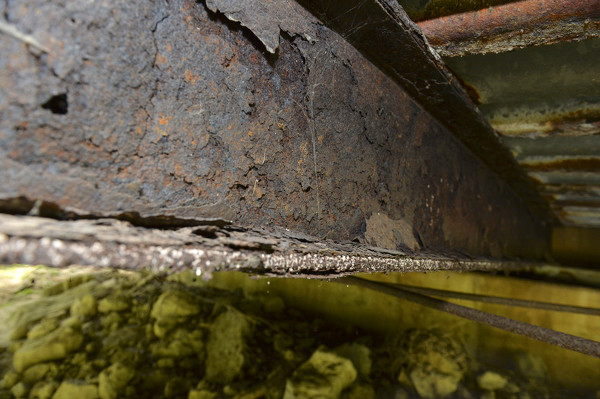
Photo by Dan Melograna/The Daily Standard
MER-CO21B-0477. Chips flake off a rusty beam on the bridge.
Wiechart argues that the most beneficial and efficient tax dollars spent for the public are those the entire public can use - roads and bridges.
"It's easy to take it for granted," Wiechart said. "But we're in the process of remaking and improving our rural county for the better."
Wiechart and Baumer both said failure to improve local roads and bridges will result in dire consequences. Shortfalls may not seem immediate, but they can pile up, Wiechart said. For example, travel and trips can still happen with degrading roads and bridges. However, that travel would likely take longer, be less reliable and less safe, Wiechart said.
An ASCE analysis of the economic effects of maintaining status quo infrastructure investments concurs with Wiechart's assessment. Based on the 2019 national economy, the analysis said that over the next 20 years, America's overdue infrastructure bill will cost the average American household $3,300 a year.
By 2039, the U.S. is expected to lose $10.3 trillion in gross domestic product from 2020-2039, or nearly half of the annual U.S. GDP in 2019, if action isn't taken.
The analysis also states that overall, if the investment gap is not addressed throughout the nation's infrastructure sectors, by 2039 the economy is expected to lose more than $2.4 trillion in exports, while imports into the U.S. economy will decrease by about $1.8 trillion, resulting in a $4 trillion loss of trade and a further loss of $626 billion in the national trade deficit. As a result, the U.S. is predicted to lose more than 3 million jobs.
As politicians in Washington argue over how the $1.7 trillion infrastructure bill will be paid for, Wiechart has said infrastructure is something people should be able to reach across the aisle to agree upon.
"There are some in public office that are more concerned about what some in the public will say about any change we may make to infrastructure," Wiechart wrote in his 2020 annual report. "What we know here is that any time we improve infrastructure and make progress through public works, some may object to the change. This office holder will not let that narrowly focused mentality impede the progress that our public expects and deserves."
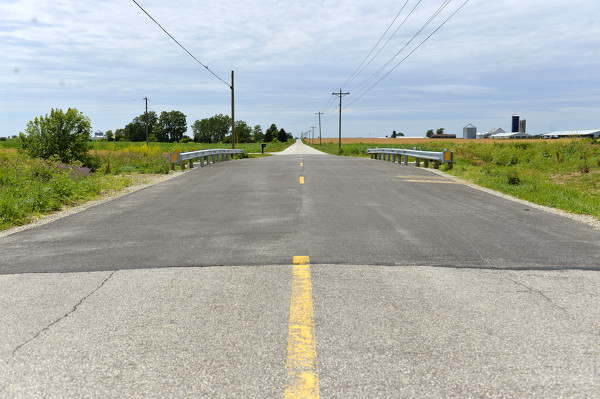
Photo by Dan Melograna/The Daily Standard
MER-TO70B-0182. This Brockman Road bridge is new, the asphalt dark.












